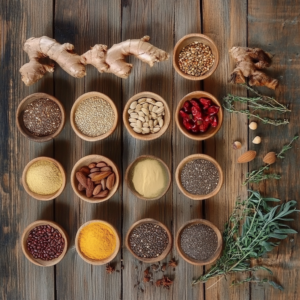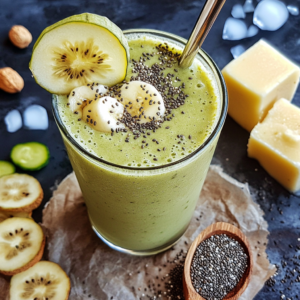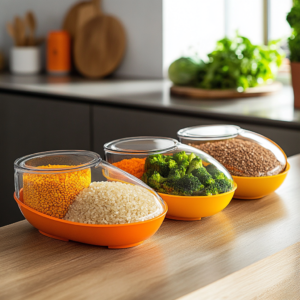1. Introduction
Every journey toward reduced pain and swelling starts in the kitchen. In this comprehensive guide, you’ll discover how Vegan Anti-Inflammatory Foods to harness nature’s pharmacy and transform your meals into powerful healing tools. We’ll break down the science of inflammation, introduce you to nutrient-packed plant foods, and provide actionable strategies—from breakfast to bedtime—to build a daily anti-inflammatory routine.
The Inflammation–Diet Connection
Chronic inflammation is often described as “silent,” gradually contributing to joint stiffness, muscle soreness, and even mood disturbances. Research from the Harvard T.H. Chan School of Public Health shows that diets rich in whole plant foods can lower markers like C-reactive protein by up to 20% in eight weeks . By focusing on vegan ingredients known to block inflammatory pathways, you’re not just masking symptoms—you’re addressing root causes.
What This Guide Offers
Foundational Knowledge: Understand key inflammatory processes and how plant compounds interfere.
Top Food Picks: A curated list of 15 anti-inflammatory vegan staples, from turmeric to berries.
Practical Meal Plans: Step-by-step daily menus that seamlessly integrate these foods.
Recipes & Tips: Creative dishes, batch-prep methods, and smart storage solutions.
Lifestyle Integration: Exercise, sleep, stress management, and gut health strategies that amplify dietary benefits.
Whether you’re a seasoned vegan cook or new to plant-based eating, this guide will equip you with everything you need to soothe inflammation and rediscover vitality—one delicious bite at a time.
2. Why Vegan Anti-Inflammatory Foods to Reduce Pain & Swelling Are Vital
In today’s world, chronic inflammation contributes to conditions ranging from arthritis to cardiovascular disease. Choosing Vegan Anti-Inflammatory Foods to reduce pain & swelling allows you to leverage an array of bioactive compounds—curcumin, omega-3s, polyphenols—that modulate your immune response and protect tissues.
The Cost of Chronic Inflammation
Left unchecked, elevated levels of pro-inflammatory cytokines (like IL-6 and TNF-alpha) can damage joints, disrupt digestion, and impair recovery after exercise . Standard Western diets, high in processed oils and refined sugars, exacerbate this cycle. By contrast, a plant-based approach supplies fiber, antioxidants, and healthy fats that actively counteract these harmful pathways.
Key Benefits of a Vegan Anti-Inflammatory Diet
Pain Relief: Natural COX-2 inhibition from turmeric matches some over-the-counter drugs without side effects .
Improved Mobility: Consistent intake of omega-3–rich seeds supports joint lubrication and flexibility.
Enhanced Recovery: Foods like ginger and berries speed muscle repair post-workout by reducing oxidative stress.
Long-Term Health: Diet patterns centered on whole foods correlate with lower incidence of diabetes, heart disease, and certain cancers.
Why “Vegan” Matters
Plant foods deliver a unique synergy of nutrients that animal-based diets can’t match—fiber to feed your gut microbiome, phytochemicals to calm immune cells, and low-saturated-fat profiles to protect cardiovascular health. For a deeper dive into essential pantry items that support this approach, visit our Vegan Pantry Essentials guide.
By embracing these foods and understanding their mechanisms, you set the stage for lasting relief from pain and swelling—empowering your body’s natural healing processes every meal of the day.
3. Understanding Chronic Inflammation and Its Impact
Inflammation is your body’s defense mechanism against pathogens and injury. Acute inflammation—like a swollen ankle after a sprain—serves a purpose: isolate damage and start healing. However, when inflammation becomes chronic, it turns destructive, attacking healthy tissues and leading to pain, reduced mobility, and systemic issues. Research explains that excess pro-inflammatory cytokines such as IL-6 and TNF-alpha circulate continuously, contributing to conditions from rheumatoid arthritis to metabolic syndrome . As someone who has guided clients through plant-based transformations, I know that diet is the most potent lever you can pull. By strategically selecting plant foods that inhibit these cytokines, you can shift your body from “fight mode” to “repair mode,” easing both internal and external swelling.
4. Essential Anti-Inflammatory Nutrients & Mechanisms
To harness the power of Vegan Anti-Inflammatory Foods to reduce pain & swelling, focus on these key nutrients and their biological actions: curcumin from turmeric inhibits COX-2 enzymes similar to ibuprofen; gingerols in ginger block prostaglandin synthesis; omega-3 fatty acids from flaxseeds and walnuts compete with pro-inflammatory arachidonic acid; polyphenols in berries and green tea suppress NF-κB, a master inflammation regulator; and dietary fiber fuels gut bacteria to produce short-chain fatty acids (SCFAs) like butyrate that calm immune activity . Integrating varied sources ensures you cover multiple pathways, creating a synergistic effect stronger than any single supplement.
5. Top 15 Vegan Anti-Inflammatory Foods
Turmeric: Stir 1–2 teaspoons of turmeric powder into soups, stews, or your morning golden milk.
Ginger: Grate fresh ginger into smoothies, dressings, and stir-fries for digestive and anti-inflammatory benefits.
Blueberries: Snack on a cup of blueberries or blend them into yogurt alternatives for anthocyanin protection.
Strawberries: Slice over oatmeal or salads; rich in vitamin C and polyphenols.
Spinach: Sauté lightly or blend into green smoothies for lutein, beta-carotene, and vitamin K.
Kale: Massage raw kale salads with lemon juice and olive oil to release antioxidants.
Flaxseeds: Grind and sprinkle on cereals, chia pudding, or baked goods for ALA omega-3 boost.
Chia Seeds: Mix into puddings or oatmeal—rich in fiber and anti-inflammatory fats.
Walnuts: Eat a handful as a snack or chop into vegan baking for extra ALA omega-3.
Almonds: Rich in vitamin E, which protects cell membranes from oxidative damage.
Olives & Extra Virgin Olive Oil: Drizzle EVOO on salads or use for low-heat cooking; rich in oleocanthal.
Tomatoes: Cook into sauces with olive oil to enhance lycopene absorption.
Broccoli: Steam or roast to preserve sulforaphane, a potent anti-inflammatory compound.
Cauliflower: Roast with turmeric and black pepper for a flavorful, anti-inflammatory side.
Green Tea: Sip 3–4 cups daily for EGCG, a polyphenol shown to lower CRP levels .
These fifteen powerhouses form the backbone of any anti-inflammatory vegan pantry. By rotating through them daily, you ensure a broad spectrum of protective compounds.

6. Creative Recipes Featuring Anti-Inflammatory Ingredients
Turmeric-Ginger Immunity Smoothie
I start my mornings with this vibrant blend: 1 cup unsweetened almond milk, ½ banana, ½ cup frozen pineapple, 1 tsp turmeric, ½ tsp fresh grated ginger, 1 tbsp ground flaxseed, and a pinch of black pepper. Blend until silky. The black pepper boosts curcumin absorption, while pineapple delivers bromelain—another anti-inflammatory enzyme.

Berry-Walnut Salad with Green Tea Vinaigrette
Toss mixed baby greens, ½ cup blueberries, ½ cup sliced strawberries, 2 tbsp chopped walnuts, and 1 tbsp chia seeds. Whisk together 2 tbsp cold-brewed green tea, 1 tbsp apple cider vinegar, 2 tbsp extra virgin olive oil, 1 tsp Dijon mustard, and a drizzle of maple syrup. This salad merges antioxidants, ALA, and polyphenols in every bite.
Roasted Cauliflower & Broccoli Bowl with Turmeric Tahini Drizzle
Roast cauliflower florets and broccoli crowns tossed in olive oil, 1 tsp turmeric, and a pinch of sea salt at 200 °C (400 °F) for 20 minutes, until edges are golden and tender. Serve over a bed of fluffy quinoa and finish with a generous drizzle of tahini sauce made following our detailed instructions in Master Vegan Cooking Tips. For guidance on enhancing gut health with pro-biotic foods, explore our in-depth article on Vegan Fermented Foods for Optimal Gut Health.
7. Daily Meal Plans & Incorporation Strategies
To sustain anti-inflammatory benefits, I recommend structuring your day around key foods:
Breakfast: Oatmeal topped with ground flaxseed, blueberries, and cinnamon.
Snack: Handful of walnuts and a cup of green tea.
Lunch: Spinach salad with ginger-citrus dressing, strawberries, almonds, and chickpeas.
Snack: Turmeric-ginger smoothie or apple slices with almond butter.
Dinner: Stir-fry of kale, tofu, broccoli, and cauliflower with garlic-ginger sauce over brown rice.
Dessert (optional): Dark chocolate (70%+) square or a small bowl of mixed berries.
By weaving Vegan Anti-Inflammatory Foods to reduce pain & swelling into every meal, you create a continuous anti-inflammatory environment in your body.
8. Meal Prep & Storage Tips for Anti-Inflammatory Foods
Batch Cooking & Portioning
Dedicate a 60-minute session each weekend to cook staples: quinoa, brown rice, and legumes. Roast trays of broccoli, cauliflower, and sweet potatoes tossed with turmeric and olive oil. Divide cooked grains and vegetables into 2-cup portions in glass meal prep containers. For sauces like our turmeric tahini or cashew-ginger cream, spoon into ice-cube trays or ½-cup silicone molds, freeze, then transfer cubes to labeled freezer bags for single-serve convenience.
Optimal Containers & Labeling
Fridge: Use wide-mouth Mason jars or BPA-free plastic containers with tight lids; sauces last 5–7 days.
Freezer: Opt for silicone molds and freezer-safe bags; sauces and smoothie packs keep 2–3 months.
Labeling: Clearly mark contents and preparation dates with waterproof labels; follow FIFO (First In, First Out) to prevent waste.
Thawing & Reheating Strategies
Quick Thaw: Pop sauce cubes into a small bowl at room temperature for 10–15 minutes.
Gentle Reheat: Warm on low heat in a saucepan, stirring in a splash of water or plant milk to restore creaminess.
Microwave Option: Defrost in short bursts (20–30 seconds), stirring between intervals to ensure even heating.
With these prep and storage techniques, you’ll always have healing ingredients at the ready—no stress, no last-minute scrambling.

9. Holistic Lifestyle Factors That Influence Inflammation
Regular Physical Activity
Engage in at least 150 minutes of moderate exercise per week—brisk walking, cycling, or swimming. Strength training twice weekly builds muscle, supports joint health, and lowers inflammatory markers like C-reactive protein .
Sleep & Recovery
Aim for 7–9 hours of uninterrupted nightly sleep. Consistent sleep patterns regulate cortisol and melatonin, key hormones in inflammation control. Create a calming pre-bed routine: dim lights, avoid screens, and consider herbal teas like chamomile.
Stress Management Techniques
Chronic stress drives up cortisol, which perpetuates inflammation. Incorporate daily practices such as:
Mindful Breathing: 5-minute diaphragmatic breaths.
Meditation or Yoga: Even 10 minutes lowers stress hormones.
Nature Therapy: Walks in green spaces reduce anxiety and inflammatory cytokines .
Gut Health & Fermented Foods
A balanced microbiome produces short-chain fatty acids (SCFAs) that soothe the immune system. Regularly enjoy probiotic-rich options—sauerkraut, kimchi, and those in our Vegan Fermented Foods for Optimal Gut Health guide—alongside prebiotic fibers from onions, garlic, and leeks.
By addressing these lifestyle pillars, you amplify the anti-inflammatory power of your diet and support whole-body resilience.
10. Monitoring Progress & Adjusting Your Anti-Inflammatory Plan
Tracking Symptoms & Food Intake
Keep a simple journal or use an app to log:
Pain levels (0–10 scale) each morning and evening
Swelling or stiffness in joints
Meals and snacks, noting key anti-inflammatory foods consumed
Using Biomarkers & Lab Tests
Work with your healthcare provider to monitor objective markers:
C-reactive protein (CRP) and erythrocyte sedimentation rate (ESR).
Omega-3 Index via a simple finger-prick blood test.
Regular testing every 3–6 months quantifies improvements and validates your dietary approach.
Seeking Professional Guidance
If you manage autoimmune conditions or chronic pain, collaborate with a registered dietitian specializing in plant-based nutrition. They can refine portion sizes, identify hidden inflammatory triggers, and incorporate specialized protocols like elimination diets when necessary.
Iterative monitoring and adjustment ensure your anti-inflammatory regimen remains aligned with your goals and health status.
11. Sustainable Shopping & Ethical Sourcing for a Low-Impact Diet
Choosing Organic & Fair-Trade Ingredients
Select certified organic turmeric and ginger to minimize pesticide residues that can impair gut barrier function. Support fair-trade producers for ingredients like coconut sugar and cacao to promote equitable labor practices.
Bulk Buying & Zero-Waste Practices
Purchase nuts, seeds, and grains in bulk using reusable canvas or mesh bags. Refill oils and vinegars at zero-waste stores to reduce single-use plastics. Store pantry staples in glass jars to extend shelf life and visibility.
Seasonal & Local Produce
Plan meals around in-season harvests:
Spring: asparagus, peas, and kale
Summer: berries, tomatoes, and zucchini
Autumn: squash, broccoli, and Brussels sprouts
Winter: citrus fruits, root vegetables, and hearty greens
Local farmers’ markets often carry these at peak freshness and lower carbon footprint compared to imported goods.
Reusable Packaging Solutions
Invest in silicone storage bags, stainless steel containers, and beeswax wraps to replace disposable cling film. Implement “bring-your-own” habits for grocery shopping and takeaway orders.
By shopping sustainably and sourcing ethically, you honor both your health and the planet—ensuring your anti-inflammatory journey remains kind to people and the environment.
12. FAQ
Q1: How quickly can I expect results from an anti-inflammatory diet? Individual responses vary; many notice reduced joint stiffness within 2–4 weeks, while chronic pain improvements may take 8–12 weeks of consistent diet and lifestyle adjustments.
Q2: Can I take supplements instead of whole foods? Whole foods deliver a spectrum of nutrients and fiber not present in isolated supplements. Use supplements as adjuncts—like curcumin capsules—but prioritize real foods for lasting benefits.
Q3: Are there any risks to a high-turmeric diet? In culinary amounts, turmeric is safe. High-dose supplements may interact with blood thinners or cause digestive upset. Consult your healthcare provider if on medication.
Q4: What if I don’t like some of these foods? Swap similar items: if you dislike kale, choose Swiss chard; if you can’t handle raw ginger, use ginger tea. Aim for variety rather than perfection.
Q5: Is cooking better than raw consumption? Some compounds become more bioavailable when cooked (e.g., lycopene in tomatoes, curcumin with heat and fat). Blend cooking methods to maximize benefits.
13. Conclusion & Next Steps
You’ve now explored why Vegan Anti-Inflammatory Foods to reduce pain & swelling are powerful allies in your quest for better health. By integrating nutrient-dense ingredients, creative recipes, smart meal plans, and lifestyle strategies, you can tip the balance toward healing and vitality. Start by choosing three new foods from this guide this week, plan a “smoothie Sunday,” and track your progress. Share your successes with our community using #VeganHealTogether. Don’t forget to subscribe to our newsletter for weekly anti-inflammatory meal ideas, recipes, and expert tips.
AFFILIATE OFFER: EXPLORE OUR PLANT-POWERED HEALING COURSE FOR DEEPER GUIDANCE, VIDEO TUTORIALS, AND PERSONALIZED SUPPORT: [INSERIR LINK DE AFILIADO AQUI]